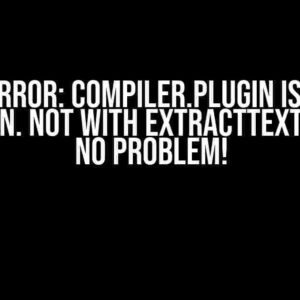Are you tired of tedious data entry and copying-pasting? Do you want to simplify your users’ experience and make your Angular application more efficient? Look no further! In this article, we’ll dive into the world of clipboard magic and explore how to get data from the clipboard using Angular.
Why Get Data from the Clipboard?
Before we dive into the implementation, let’s discuss the benefits of getting data from the clipboard:
- Improved User Experience**: By allowing users to paste data directly from the clipboard, you can save them time and effort, making your application more user-friendly.
- Increased Efficiency**: Automatically populating form fields or data tables with clipboard data can significantly reduce the time spent on data entry.
- Enhanced Productivity**: With the ability to retrieve data from the clipboard, you can create more complex and dynamic applications that integrate seamlessly with other tools and systems.
Using the Clipboard API in Angular
The Clipboard API is a modern web API that provides access to the system clipboard, allowing you to read and write data to it. Angular provides a simple way to interact with this API through the `navigator.clipboard` object.
Clipboard API Methods
The Clipboard API offers two primary methods for interacting with the clipboard:
readText(): Retrieves the text content of the clipboard.writeText(): Writes text content to the clipboard.
Getting Data from the Clipboard in Angular
To get data from the clipboard in an Angular application, you’ll need to create a component that interacts with the Clipboard API. Here’s a step-by-step guide to get you started:
Step 1: Create a New Component
Create a new Angular component using the Angular CLI or your preferred method:
ng generate component clipboard-exampleStep 2: Import the necessary modules
In your component’s module file (`clipboard-example.module.ts`), import the necessary modules:
import { NgModule } from '@angular/core';
import { CommonModule } from '@angular/common';
import { ClipboardExampleComponent } from './clipboard-example.component';
@NgModule({
declarations: [ClipboardExampleComponent],
imports: [CommonModule],
exports: [ClipboardExampleComponent]
})
export class ClipboardExampleModule { }Step 3: Create the Component Template
Create a simple template for your component (`clipboard-example.component.html`):
<div>
<button (click)="pasteFromClipboard()">Paste from Clipboard</button>
<textarea [(ngModel)]="clipboardData"></textarea>
</div>Step 4: Implement the Clipboard Logic
In your component file (`clipboard-example.component.ts`), add the necessary logic to interact with the clipboard:
import { Component } from '@angular/core';
@Component({
selector: 'app-clipboard-example',
templateUrl: './clipboard-example.component.html',
styleUrls: ['./clipboard-example.component.css']
})
export class ClipboardExampleComponent {
clipboardData = '';
async pasteFromClipboard() {
try {
const text = await navigator.clipboard.readText();
this.clipboardData = text;
} catch (error) {
console.error('Error reading from clipboard:', error);
}
}
}Handling Clipboard Data
Once you’ve retrieved the clipboard data, you can process it as needed. Here are some common scenarios:
Scenario 1: Pasting Text Data
When pasting text data, you can simply display the text in a UI component, such as a text area or input field.
<textarea [(ngModel)]="clipboardData"></textarea>Scenario 2: Pasting JSON Data
When pasting JSON data, you can parse the JSON string and use the resulting object:
const jsonData = JSON.parse(clipboardData);
console.log(jsonData); // { key: 'value', ... }Scenario 3: Pasting CSV Data
When pasting CSV data, you can parse the CSV string and use the resulting array:
const csvData = clipboardData.split('\n').map(row => row.split(','));
console.log(csvData); // [[cell1, cell2, ...], [cell1, cell2, ...]]Security Considerations
When working with the Clipboard API, it’s essential to consider security implications:
- Clipboard Snooping**: Malicious scripts can access sensitive data on the clipboard, so ensure you only request access when necessary.
- Data Validation**: Always validate user-pasted data to prevent injection attacks or data corruption.
- Permission prompt**: The Clipboard API may prompt users for permission to access the clipboard, so ensure you handle this prompt gracefully.
Conclusion
Getting data from the clipboard in Angular is a powerful feature that can enhance your application’s user experience and efficiency. By following this guide, you can unlock the potential of the Clipboard API and create more dynamic, user-friendly applications.
| Method | Description |
|---|---|
readText() |
Retrieves the text content of the clipboard. |
writeText() |
Writes text content to the clipboard. |
Remember to handle security considerations and adapt this guide to your specific use case. Happy coding!
Frequently Asked Question
Get the scoop on how to harness the power of the clipboard in your Angular application!
How do I access the clipboard data in my Angular application?
You can use the `navigator.clipboard` API to access the clipboard data in your Angular application. Specifically, you can use the `readText()` method to read the text data from the clipboard.
Do I need to add any permissions to access the clipboard data?
Yes, you need to add the `’clipboard-read’` permission to your Angular application to access the clipboard data. You can do this by adding the permission to your `manifest.json` file or by using the `navigator.permissions.query()` method to request the permission at runtime.
How do I handle errors when accessing the clipboard data?
You can use try-catch blocks to handle errors when accessing the clipboard data. For example, you can catch the `DOMException` error that is thrown when the user denies access to the clipboard. You can also use the `catch` method to handle any other errors that may occur.
Can I use the clipboard data in a Angular service?
Yes, you can use the clipboard data in an Angular service. You can inject the `navigator` object into your service and use it to access the clipboard data. This way, you can encapsulate the clipboard logic in a separate service and reuse it across your application.
Is there a way to programmatically set the clipboard data in Angular?
Yes, you can use the `navigator.clipboard` API to set the clipboard data programmatically in Angular. Specifically, you can use the `writeText()` method to write text data to the clipboard.



![Solving the “v-select drop down error [object Object] selected the value” Conundrum: A Step-by-Step Guide Solving the “v-select drop down error [object Object] selected the value” Conundrum: A Step-by-Step Guide](https://fringilla.hkhazo.biz.id/wp-content/uploads/sites/572/2024/07/solving-the-v-select-drop-down-error-object-object-selected-the-value-conundrum-a-step-by-step-guide-with-text-300x300.jpg)